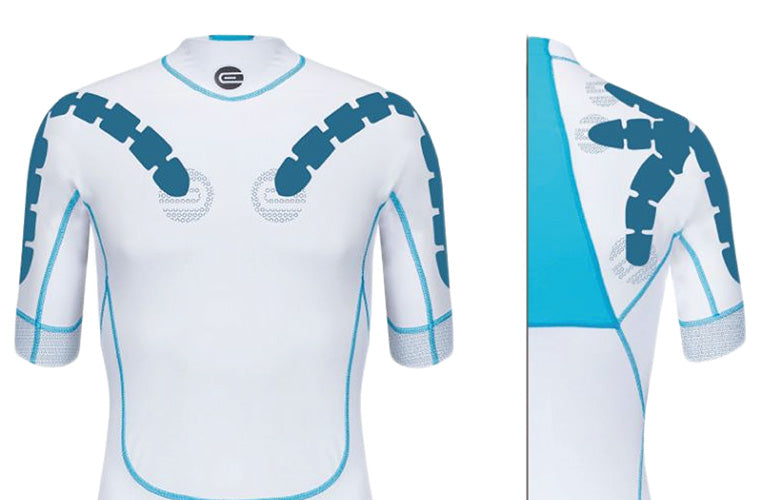Your Cart is Empty

Delivered every working day, our email newsletter inspires the world's greatest sports innovators to create the future of sport. Enter your email below to subscribe - it's FREE!!!!
Sports injuries are unfortunately an unavoidable part of living an active life. A quick Google search brings up hundreds of methods to treat, manage, and support injuries during rehab and return to exercise. In recent years we’ve seen a substantial increase in the use of kinesiology tape, either applied at home or by physiotherapists, typically to provide muscle and joint support.
Developed in Japan in the 1970’s, and popularised as a result of the 2008 and 2012 Olympic Games, K-tape is showing no signs of disappearing, with the worldwide market estimated to reach over $430m by 2025. But is there any science behind this trend, and what’s next in the world of therapeutic taping?
We spoke with Dr. Chris Peploe from Exosuit, a new performance sportswear brand combining active compression with flexible support that mimics K-tape, to find out more.
Quick links:
Traditionally, athletes with muscular injury would use tape to restrict motion and prevent further strain to the affected region. K-tape essentially takes the opposite approach, attempting to create space for full movement, stabilising the injured area without restricting range-of-motion. K-tape manufacturers typically claim three key benefits:

Well, in short, the jury is still out. Although a number of studies have investigated the claimed benefits of K-tape, there is still a lack of high-quality evidence to back up its use.
Typically, research has looked into three outcome measures when investigating the effects of K-tape: pain relief, range-of-motion, and performance enhancement including strength.
In terms of pain relief, studies investigating back and shoulder pain have found short-term (24-hour) benefits, while meta-analyses of a larger body of research suggest that K-tape can be used to relieve pain in individuals with a range of musculoskeletal injuries, although reductions may not be more clinically meaningful than existing treatments.
Range-of-motion and performance enhancement findings are again somewhat inconsistent. Improvements in range-of-motion were found in studies investigating cervical spine and shoulder movement, while increased strength and muscle activation has been seen in hand grip and quadriceps peak torque activities.
Unfortunately for every finding in favour of K-tape, we find several non-significant results creating uncertainty and calling for further research.
The fact is that K-tape is almost certainly one of those products where the truth is somewhere in the middle. There is definitely hype, and probably something positive in the science, although hard evidence is limited.
K-tape is at the very least a relatively inexpensive, easy, and low risk way to create new sensations and body awareness during exercise, and if that makes people feel good and build confidence then why not try it for yourself, and look awesome at the same time.

Although K-taping techniques and applications continue to grow, with specific courses available for speech therapists, midwives, paediatrics, lymphologists, and even equine kinesiology, the technology itself has been relatively unchanged for the past 10+ years.
With an increasing demand from athletes for truly functional products that can either assist in injury prevention, support, or performance enhancement, companies are beginning to look at the apparel space in combination with therapeutic taping as an opportunity to innovate.
In short, taped clothing combines compression with integrated structures that in some way mimic K-tape, or the supportive elements of strapping and joint braces.
The integration of support structures into garments really began with postural supports, ranging from hardcore braces that guide the wearer into a more neutral position, to more subtle garments promoting a straighter back during sitting and standing. More recently a few companies have started integrating flexible structures into garments targeted specifically at sportspeople, with claimed benefits ranging from muscle & joint support, to fatigue reduction and enhanced recovery. By combining typically compression with support, manufacturers are able to offer greater functionality to the wearer in one easy-to-use package.

At Exosuit, we’ve combined active compression with our patented PowerFlex Technology, in garments that gently interact with the body to support and power performance. While K-tape and some other manufacturers’ garments rely on adhering to the wearer’s body along their length, Exosuit interacts with the body via small silicone panels at key anatomical locations, targeting support and power around specific muscles and joints.
Our first menswear product, the EXO1, provides stability around the shoulder and upper back, while also supporting posture, enhancing body awareness, and promoting a feeling of power. We’re bored of all the big brands offering almost identical compression garments. We want to create functional synergy between athlete and garment, to truly support and enhance performance.

Exosuit is designed with sports injury in mind, specifically to help with injury prevention, or to support an existing injury or weakness during rehab or return to exercise.
The EXO1 top targets upper body intensive sports, ranging from hitting and throwing sports such as tennis, cricket, baseball, and golf, through to Crossfit and more general gym use. Anyone requiring additional shoulder and upper back support during their sport should absolutely give the EXO1 a go. Over the coming months our range will be expanding, so please keep an eye out for the next Exosuit garments as they hit the market.
Like the content and want to be ahead of the curve? Enter your email below to subscribe - it's FREE!!!!
This is an official post by the team at Kit Radar. Supporting sports startups, science and technology.